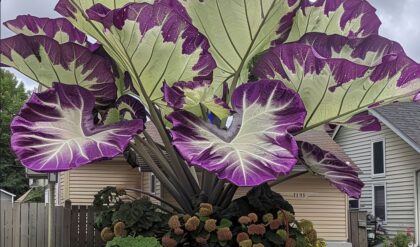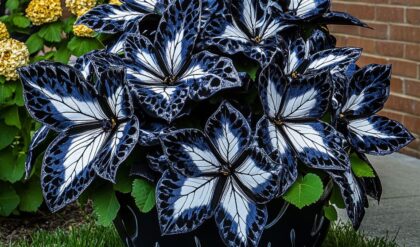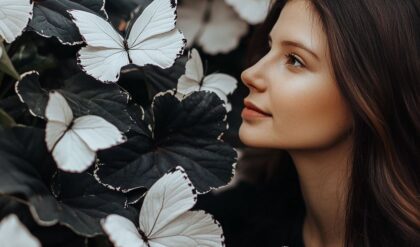The Begonia Moonlight Butterfly stands as a testament to nature’s artistry, captivating plant enthusiasts with its ethereal charm and delicate beauty. This exquisite variety of begonia has earned its place as a coveted specimen in gardens and indoor spaces alike, enchanting observers with its unique foliage and graceful presence. In this comprehensive exploration, we’ll delve into the mesmerizing world of the Begonia Moonlight Butterfly, uncovering its distinctive characteristics, cultivation requirements, and the magic it brings to any environment it graces.
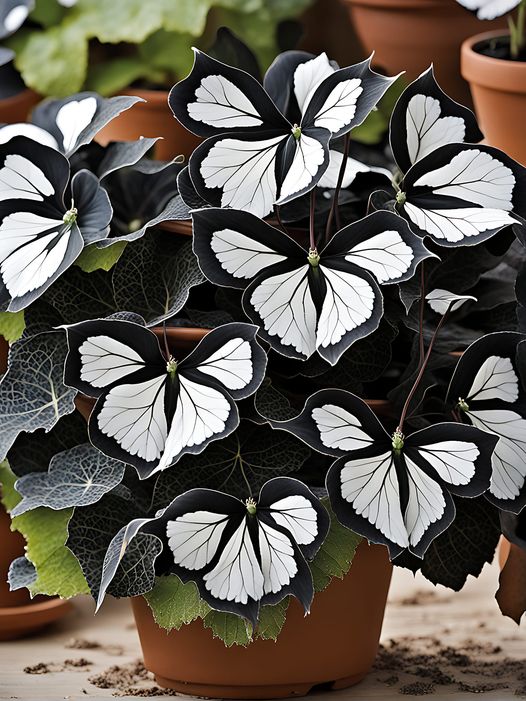
The Allure of Begonia Moonlight Butterfly
The Begonia Moonlight Butterfly is a true masterpiece of nature, combining subtle elegance with captivating visual appeal. Its unique characteristics set it apart from other begonia varieties, making it a prized possession for plant enthusiasts and gardeners alike.
Foliage that Dances with Light
The leaves of the Begonia Moonlight Butterfly are its most striking feature. Shaped like delicate butterfly wings, they emerge in a deep, rich green before transforming into a mesmerizing palette of silvery-green and pewter. This color shift creates an enchanting play of light and shadow across the plant’s surface, reminiscent of moonlight filtering through a dense forest canopy.

The foliage is further adorned with intricate veining patterns, adding depth and texture to each leaf. These veins, often tinged with deep crimson, create a stark contrast against the lighter background, enhancing the overall visual appeal of the plant. As light dances across the leaves, it creates a shimmering effect that truly brings the “Moonlight Butterfly” name to life.
This unique coloration and patterning make the Begonia Moonlight Butterfly an excellent choice for adding visual interest to shaded areas of gardens or bringing a touch of natural elegance to indoor spaces. The plant’s ability to thrive in low-light conditions while maintaining its stunning appearance makes it a versatile and highly sought-after specimen.
Growth Habit and Structure
The Begonia Moonlight Butterfly typically reaches a height of 12-18 inches, with a similar spread. This compact growth habit makes it ideal for use in hanging baskets, terrariums, or as a stunning centerpiece in decorative containers. The plant’s natural tendency to grow in a slightly cascading manner adds to its charm, creating a lush, full appearance that can soften the edges of any space it occupies.
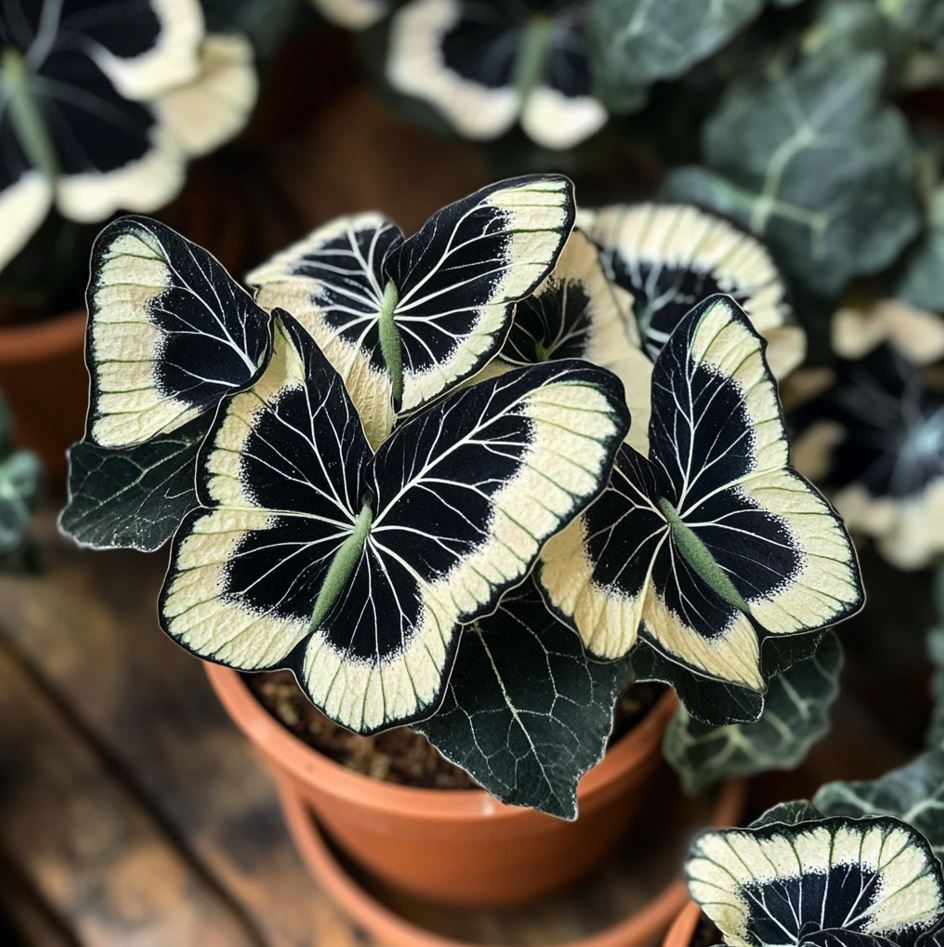
As the plant matures, it develops multiple stems, each adorned with an array of those signature wing-shaped leaves. This creates a dense, layered appearance that adds depth and complexity to the overall structure of the plant. The resulting form is both elegant and intriguing, inviting closer inspection to fully appreciate the intricate details of each leaf.
Delicate Blooms: Nature’s Perfect Complement
While the foliage of the Begonia Moonlight Butterfly is undoubtedly its star feature, the plant also produces delicate, pale pink flowers that add another layer of beauty to its overall appearance. These blooms, though small and subtle, provide a perfect complement to the striking leaves, softening the overall look of the plant and adding a touch of romance to its character.
The flowers typically appear in clusters, emerging from between the leaves on slender stems. Their pale pink color creates a beautiful contrast against the silvery-green foliage, adding depth and dimension to the plant’s visual appeal. While not as showy as some other begonia varieties, these blooms contribute to the plant’s overall charm and serve as a reminder of the Begonia Moonlight Butterfly’s place within the diverse and colorful world of flowering plants.
Cultivating Your Own Moonlight Magic
Growing a Begonia Moonlight Butterfly can be a rewarding experience for gardeners of all skill levels. By understanding and meeting the plant’s specific needs, you can create an environment where this exquisite beauty will thrive and flourish.

Creating the Perfect Growing Environment
To successfully cultivate a Begonia Moonlight Butterfly, it’s crucial to replicate its natural habitat as closely as possible. This begins with understanding the plant’s preferences for light, temperature, and humidity.
Light requirements are perhaps the most critical factor in successfully growing this begonia variety. The Moonlight Butterfly thrives in bright, indirect light, making it an excellent choice for east or north-facing windows in indoor settings. When grown outdoors, it prefers dappled shade or areas that receive morning sun followed by afternoon shade. Direct sunlight, especially during the hottest parts of the day, can scorch the delicate leaves and cause irreparable damage to the plant.
Temperature control is another essential aspect of cultivating the Begonia Moonlight Butterfly. These plants prefer warm, stable temperatures ranging from 65-75°F (18-24°C). They are not frost-hardy and should be protected from cold drafts and sudden temperature fluctuations. In regions with cold winters, it’s best to grow these plants indoors or in greenhouses where temperature can be regulated.
Humidity plays a significant role in the health and appearance of the Begonia Moonlight Butterfly. These plants thrive in environments with higher humidity levels, typically around 50-60%. In drier climates or during winter months when indoor heating can reduce humidity, additional measures may be necessary to maintain the ideal moisture levels around the plant.
Soil and Potting Considerations
The right potting mix is crucial for the health and growth of your Begonia Moonlight Butterfly. These plants require a well-draining, loose soil that allows for proper aeration of the roots while retaining enough moisture to keep the plant hydrated.

A recommended potting mix for the Begonia Moonlight Butterfly consists of equal parts peat moss, perlite, and vermiculite. This combination provides the perfect balance of water retention and drainage, preventing issues like root rot while ensuring the plant has access to the moisture it needs.
When potting or repotting your Begonia Moonlight Butterfly, choose a container with adequate drainage holes to prevent water from pooling at the bottom. The pot should be just slightly larger than the root ball of the plant, as begonias generally prefer to be slightly root-bound. This also helps prevent overwatering, which can be detrimental to the plant’s health.
Watering Wisdom: Finding the Right Balance
Proper watering is crucial for maintaining the health and vibrancy of your Begonia Moonlight Butterfly. These plants prefer consistent moisture but are susceptible to root rot if overwatered. The key is to find a balance that keeps the soil consistently moist but never soggy.
A good rule of thumb is to water your Begonia Moonlight Butterfly when the top inch of soil feels dry to the touch. When watering, do so thoroughly until water runs out of the drainage holes at the bottom of the pot. This ensures that water reaches all parts of the root system. After watering, allow any excess water to drain completely, and never let the plant sit in standing water.
During the growing season (spring and summer), you may need to water more frequently. In contrast, reduce watering during the plant’s dormant period in winter. Always adjust your watering schedule based on environmental factors such as temperature, humidity, and the amount of light the plant receives.
Feeding for Flourishing Growth
To encourage healthy growth and maintain the vibrant coloration of the Begonia Moonlight Butterfly’s foliage, regular fertilization is necessary. During the growing season (spring through fall), feed your plant with a balanced, water-soluble fertilizer diluted to half the recommended strength every two to three weeks.
Choose a fertilizer with equal parts nitrogen, phosphorus, and potassium (such as a 10-10-10 or 20-20-20 formula) to support overall plant health, leaf development, and flower production. It’s important not to over-fertilize, as this can lead to salt buildup in the soil and potentially damage the plant’s delicate root system.
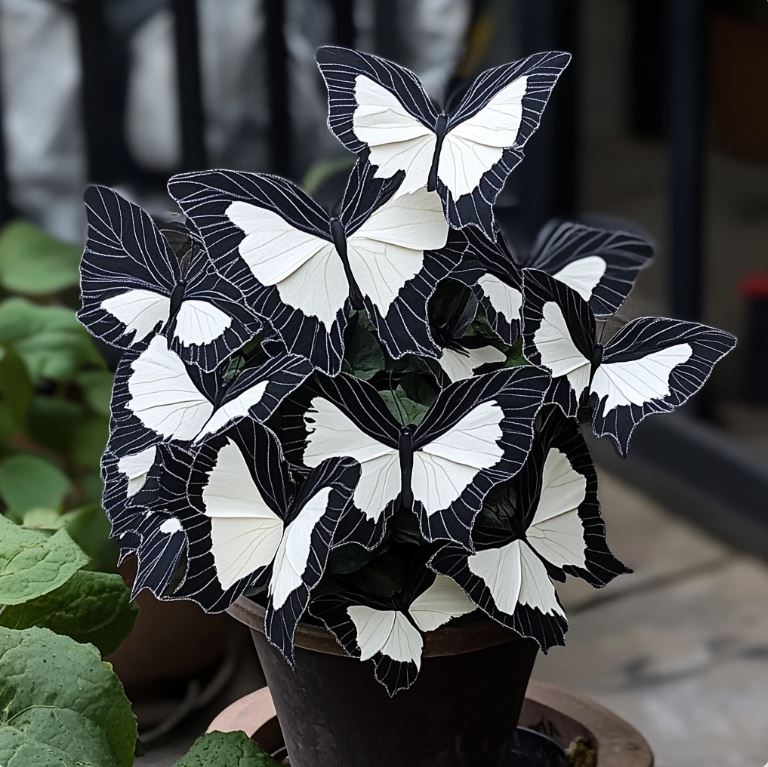
During the winter months, when the plant’s growth naturally slows, reduce or stop fertilization altogether. Resume feeding in early spring when you notice new growth beginning to emerge.
Troubleshooting Common Issues and Maintaining Health
Even with the best care, your Begonia Moonlight Butterfly may occasionally face challenges. Being aware of potential issues and knowing how to address them can help you maintain a healthy, thriving plant.
Recognizing and Addressing Pest Problems
Like many houseplants, the Begonia Moonlight Butterfly can be susceptible to certain pests. Regular inspection of your plant can help you catch and address any infestations early, before they become severe.
Common pests that may affect your Begonia Moonlight Butterfly include:
- Aphids: These small, soft-bodied insects can cluster on new growth and undersides of leaves. They can be removed with a strong spray of water or treated with insecticidal soap.
- Mealybugs: These white, cottony pests often gather in leaf axils and on stems. They can be removed with a cotton swab dipped in rubbing alcohol or treated with neem oil.
- Spider mites: These tiny arachnids can cause stippling on leaves and create fine webbing. Increasing humidity and treating with insecticidal soap or neem oil can help control infestations.
Early detection and prompt treatment are key to managing pest issues effectively. Always isolate affected plants to prevent the spread of pests to other houseplants.
Dealing with Diseases and Environmental Stress
The Begonia Moonlight Butterfly can be prone to certain diseases, particularly in conditions of high humidity and poor air circulation. Some common issues include:
- Powdery mildew: This fungal disease appears as a white, powdery coating on leaves. Improve air circulation and treat with a fungicide if necessary.
- Botrytis blight: This fungal infection causes gray, fuzzy mold on leaves and flowers. Remove affected parts and improve air circulation to prevent spread.
- Root rot: Caused by overwatering or poor drainage, root rot can be fatal if not addressed quickly. Ensure proper drainage and adjust watering practices to prevent this issue.
Environmental stress can also affect the health of your Begonia Moonlight Butterfly. Symptoms like leaf yellowing, brown edges, or leaf drop can indicate issues with light, temperature, or humidity. Regularly assess your plant’s environment and make adjustments as needed to ensure optimal growing conditions.
Pruning and Grooming for Optimal Growth
Regular pruning and grooming can help maintain the shape and health of your Begonia Moonlight Butterfly. Remove any dead, damaged, or yellowing leaves promptly to prevent the spread of disease and maintain the plant’s attractive appearance.
Pinching back the growing tips of stems can encourage bushier growth and prevent the plant from becoming leggy. This is particularly useful if you’re growing the Begonia Moonlight Butterfly in a hanging basket or as a compact tabletop plant.
When pruning, always use clean, sharp scissors or pruning shears to make clean cuts and minimize the risk of infection. Dispose of pruned material away from your other plants to prevent the spread of any potential diseases.
Conclusion: Embracing the Magic of the Moonlight Butterfly
The Begonia Moonlight Butterfly is more than just a plant; it’s a living work of art that brings a touch of enchantment to any space it occupies. Its unique foliage, with its captivating play of light and shadow, serves as a constant reminder of the beauty and diversity found in the natural world.
By providing the right care and attention, you can cultivate your own piece of botanical magic, watching as your Begonia Moonlight Butterfly flourishes and evolves throughout the seasons. Whether displayed as a standalone specimen or incorporated into a larger collection of plants, this exquisite begonia variety is sure to captivate and inspire all who encounter it.
As you embark on your journey with the Begonia Moonlight Butterfly, remember that each plant is unique, with its own personality and quirks. Embrace the learning process, celebrate the small victories, and don’t be discouraged by occasional setbacks. With patience, care, and a touch of horticultural magic, you’ll soon find yourself the proud caretaker of one of nature’s most enchanting creations – a thriving Begonia Moonlight Butterfly, bringing a piece of moonlit wonder into your everyday life.


